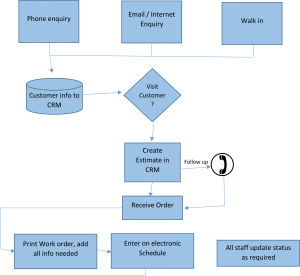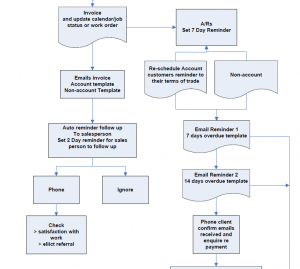
Efficiency gains from improved systems undoubtedly increases company profits, but did you know that typically it improves customer and staff satisfaction as well. Our experience has shown that good systems, leads to happier staff, suppliers, customers and shareholders. So, it’s a Win / Win / Win / Win situation.
To improve your business, invest some time reviewing and documenting your workflow in all parts of the business: It takes a bit of time but it will pay back year after year.
Just some of the areas to look at would be
- Marketing
- Customer Acquisitions
- Customer Retention
- Sales
- Accounts Receivables
- Production
- Shipping etc
In theory, business is simple!
- Company has a product.
- Company supplies product to customer.
- Customer gives money to company.
What could be easier?
Well it never is that easy, is it? There are endless phone calls and emails, marketing activities, quoting, prioritising customers, product requirements to clarify, production challenges, delivery, accounts receivables, and so on.
If you, your staff, or your customers aren’t clear about the processes, then you’re losing time and money.
Having clear processes that everyone understands with the right tools for implementation is the key to a happy, profitable workplace.
Investing some time to review your systems will provide a big payback for years to come.
Here’s how to do it.
Stage 1: Document your workflows!
First: Be clear about your overall objective. Normally providing a product at the best margins and getting paid. Then start with documenting your current workflow.
- Document the series of steps involved to reach the objective
- List tasks and documents involved in each step
- Identifying the order that each task needs to occur in
There is a plethora of software out there to help you do this or you can just go plain and simple and use something like Microsoft Word
Here’s an example of a simplistic workflow.

Stage 2: Identify and fix the gaps!
Look for the gaps (opportunities missed) and add or modify processes to fill those gaps. E.g. are you asking for referrals with every completed job?
Stage 3: Look for black holes!
Is there a part of your workflow where you expect staff to just know what happens? Something goes in, something comes out. Is it always perfect? If not think about how it should happen, not how it does happen.
Stage 4: Clarify responsibility!
Is it clear who does what? If not, add names or titles to each of the tasks.
Stage 5: Build the tools
This is the part that really adds to efficiencies. Look at each stage of your workflow and build or adopt the tools necessary to automate processes as much as possible. These tools may be new software or just email templates or network folders or old-fashioned pigeonholes, etc. Use whatever works for your business.
Many CRMs and ERPs can have these workflows and tools built in, but do they cover all facets of your business? Or have you given it thought and programmed your ERP or CRM correctly?
Here’s a sample of a more fleshed out Accounts Receivables process we completed for a client. This process along with email templates and a reminder system improved their days receivable from 72 down to 38 days. That’s less stress, less risk and a lot of cash in the bank! Plus, the staff were happier and repeat orders were higher.

For a free no obligation discussion about how we can help you,
